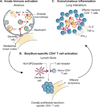Beryllium-Induced Hypersensitivity: Genetic Susceptibility and Neoantigen Generation
- PMID: 26685315
- PMCID: PMC4685955
- DOI: 10.4049/jimmunol.1502011
Beryllium-Induced Hypersensitivity: Genetic Susceptibility and Neoantigen Generation
Abstract
Chronic beryllium (Be) disease is a granulomatous lung disorder that results from Be exposure in a genetically susceptible host. The disease is characterized by the accumulation of Be-responsive CD4(+) T cells in the lung, and genetic susceptibility is primarily linked to HLA-DPB1 alleles possessing a glutamic acid at position 69 of the β-chain. Recent structural analysis of a Be-specific TCR interacting with a Be-loaded HLA-DP2-peptide complex revealed that Be is coordinated by amino acid residues derived from the HLA-DP2 β-chain and peptide and showed that the TCR does not directly interact with the Be(2+) cation. Rather, the TCR recognizes a modified HLA-DP2-peptide complex with charge and conformational changes. Collectively, these findings provide a structural basis for the development of this occupational lung disease through the ability of Be to induce posttranslational modifications in preexisting HLA-DP2-peptide complexes, resulting in the creation of neoantigens.
Copyright © 2015 by The American Association of Immunologists, Inc.
Figures


References
-
- Balmes JR, Abraham JL, Dweik RA, Fireman E, Fontenot AP, Maier LA, Muller-Quernheim J, Ostiguy G, Pepper LD, Saltini C, Schuler CR, Takaro TK, Wambach PF. An official American Thoracic Society statement: diagnosis and management of beryllium sensitivity and chronic beryllium disease. Am. J. Respir. Crit. Care Med. 2014;190:e34–e59. - PubMed
-
- Henneberger PK, Goe SK, Miller WE, Doney B, Groce DW. Industries in the United States with airborne beryllium exposure and estimates of the number of current workers potentially exposed. J Occup. Environ. Hyg. 2004;1:648–659. - PubMed
-
- Jaskula BW. Minerals Yearbook. Vol. 2015. Washington, D.C.: US Geological Survey; 2013. pp. 1–8.
-
- Weber H, Engelhardt WE. Investigation of dust arising out of beryllium extraction. Gewerbehyg Unfallverhuet. 1933;10:41.
-
- Gelman I. Poisoning by vapors of beryllium oxyfluoride. J Ind. Hyg. Toxicol. 1936;18:371–399.
Publication types
MeSH terms
Substances
Grants and funding
LinkOut - more resources
Full Text Sources
Other Literature Sources
Research Materials

